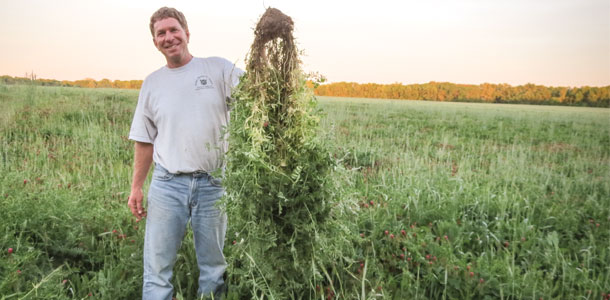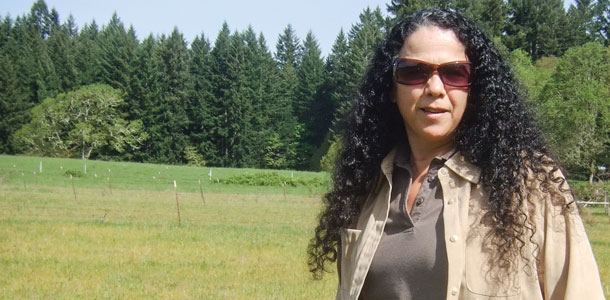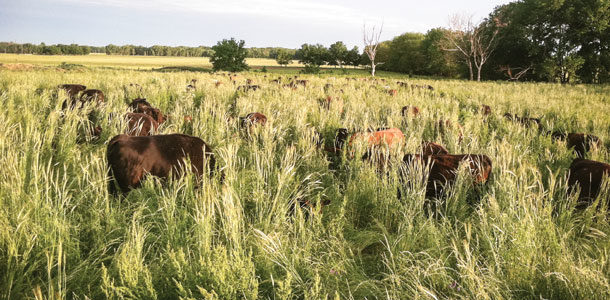Kansas farmer Gail Fuller (near Emporia) experimented with no-till farming during the 1980s. Later he started grazing cover crops with cattle. During the past few years he has also been experimenting with pasture cropping.
“This idea came from Colin Seis in Australia, trying to farm in native rangeland. In the perennial system I have, I am now trying to introduce cool-season perennials or re-establish warm-season perennials.

I don’t want to interfere with land that’s never been broken or introduce anything that’s never been there,” Fuller says.
“We plant a cash crop as the perennial is going dormant after grazing. What Colin does is keep grazing every year, and then one year out of four he grows a cash grain crop – an off-season crop to whatever the grass is.
I’d never heard of pasture cropping until I met Colin. I’d looked at what Argentina farmers had done, using four to six years in a perennial setting with mob grazing, then putting the land into cash crops for five to 10 years and then putting it back into perennials,” he explains.
“Then I met Colin, and I think pasture cropping will work better for my situation. This is the path I’m on now. Our first perennials are coming back next year into cropping. We will put some pasture cropping in, too, to see what’s best,” says Fuller.
Relay cropping
Many dairies in western Oregon grow field corn for silage, planted in April or May. The idea of relay cropping was introduced to Canadian dairymen by researchers in British Columbia at the Agassiz Research Station, and this practice was copied in the Pacific Northwest.
Michael Gangwer (extension dairy specialist with Oregon State University during the 1990s) worked with relay cropping in the Willamette Valley and published a report in 1999.
Dairymen in his area were planting Italian ryegrass (an annual) between 30-inch corn rows when the corn was three to four weeks old.
The goal is to have grass already germinated and growing when the corn is harvested. This eliminates the need for planting it in the fall (double-cropping) when rain might make it difficult.
Selecting forage species
Shelby Filley, a regional livestock and forage extension specialist with Oregon State University, assists livestock graziers with pasture management and productivity.
“I help them take soil samples and talk about intensive systems. Here in western Oregon we usually have 30 to 90 inches of rainfall. Our winters are usually open; many people continue to graze cattle through winter,” she says.
She helps stockmen select forage species that match their soil, climate and environment. “We have so many different soils; some are poorly drained while others are well drained.
This makes a difference on which species works best. Orchardgrass, for instance, needs well-drained soil. It’s also important to match grasses and legumes together that have similar management requirements and try to apply the appropriate management to the pasture,” she says.
“We have trouble with forage growth with cool-season grasses during the hottest part of summer. Not everyone has irrigation, so some plants don’t grow as well and some producers start running out of forage.
The grass also changes from high-quality vegetative growth to reproductive growth – stems and seeds, and increased fiber.” The nutrient value, palatability and digestibility decrease. So then you need species that can keep a forage system going in those conditions.
“I am part of the Oregon Forage and Grasslands Council, which is part of the American Forage and Grasslands Council. Many people in our group, in our area, are seed growers,” she says.
The Willamette Valley is the world’s leading producer of ryegrass seed. Fescue, orchardgrass and other grass seed is also grown.
“We have dozens of seed companies that do research, and a well-developed seed industry here, so the Oregon Forage and Grasslands Council is made up of university people, students, extension, researchers, seed and hay producers, livestock producers, etc. We all get together and figure out what we need to work on to provide good forage for our animals,” she says.
“We have some demonstration projects where the seed companies give us their best forages that they think will grow throughout the heat of summer.
Oregon State University has land we use for forage demonstration trials. Currently we have about six different types of forage on some five-acre paddocks.
We grazed them with lightweight calves to compare forage growth and calf gain as a demonstration. We had different combinations, trying to find ways to produce more forage on the off seasons.”
Troy Downing, Oregon State University dairy extension specialist, says some farmers and ranchers in his area are double-cropping, planting a grass or annual forage species in the same field with corn to have a cover crop and some annual grass growing during winter for cattle to graze.
For example, if you plant annual ryegrass in the cornfield early in the season, by the time you cut the corn you already have something else growing, going into winter. The grass crop can capture additional nutrients, stabilize the soil and extend forage resources through the winter.
“Pasture cropping – adding a crop periodically to a stand of permanent pasture during the time of year the pasture forage is dormant – is being done in places like Australia where they are dealing with drought and appreciate the qualities provided by permanent pasture.
It leads to stable soil, building more carbon in the soil, etc. In some instances, farmers are able to drill small grains into the pasture that can grow when the grass is dormant,” says Downing.
“In northern California, warm-season species that thrive in hot weather perform totally different than our cool-season grasses like fescues and orchardgrasses.
The warm-season grasses don’t do well on a 40ºF day in the Sacramento Valley in February, for instance, whereas cool-season grasses do.
Often people use a mix with orchardgrass for winter growth. It would go dormant in hot weather, but at that time Dallas grass and bermudagrass would provide summer growth,” he says.
“In pastures with warm-season grasses that go dormant in the fall, you could drill in some small grains like wheat, oats or barley and get good growth on those.
When you have an environment with extreme temperatures, you could drill something into the field that is really competitive, that would grow during the winter when the rest of the plants won’t be doing much until it warms up again in the spring.” There are advantages to having two crops growing on the same land base. FG
Heather Smith Thomas is a freelance writer based in Idaho.
PHOTOS
PHOTO 1: Gail Fuller uses high-density grazing in his new pasture cropping rotation.
PHOTO 2: Gail Fuller, a Kansas farmer, shows plant density and root health in one of his pastures.
PHOTO 3: Shelby Filley with Oregon State University extension works with farmers and ranchers to improve their crops and pastures. Photos courtesy of Shelby Filley.
Harvesting extra forage
Good pasture can sometimes be more productive than cutting it for hay, since there is often more re-growth and total forage harvested.
There are times during the peak growing season the pasture may get ahead of the cattle, however. In this instance it pays to be able to cut some for hay or haylage.
Glenn Shewmaker, state forage specialist, University of Idaho, says that for a few years his family rented some land with pivots for irrigated pasture.
“We’d take off about 40 percent of it as hay and use the re-growth for pasture. We had plenty of grass for the cattle in May and June, so we cut those fields for hay. In July and August, we used the regrowth for pasture. This type of management can work well if a person already has the haying equipment or can contract the haying,” he says.
“If we tried to graze it all, we couldn’t get through all the fields quickly enough in the early part of the season; the forage was growing so fast that it got ahead of us and became stemmy.
It must be immature for best nutrient quality, so we cut it for hay at that point. Then with the lower growth rate during July and August we pastured it, without having to adjust our stocking numbers.” Cutting the first growth early and pasturing it later helped smooth out the growth curve to match cattle numbers.
“I don’t follow the current line of thinking that recommends selling all haying equipment when going to a pasture-based operation. If you have the equipment, it can be handy if you need it some years or for some fields if forage gets ahead of the grazing animals,” says Shewmaker.
Otherwise you’d need to bring in more cattle during the peak growing season to utilize the abundant growth before it becomes too mature.
If you can make hay at an optimum time, this gives you hay to sell or to keep on hand for a bad winter when stockpiled pastures are snowed under or inadequate due to drought.
Filley says the problem in western Oregon is that it’s hard to put up hay because the ground is too wet. It may also be raining during June and July when people would be trying to cut hay.
“More and more producers are harvesting their extra forage as high-moisture haylage. Then it can be cut earlier. You can put it up moist, but you have to wrap it tightly, and it goes through a fermentation process,” she says.
Every farm and ranch is different, and people have to find ways to make things work on their own place.











